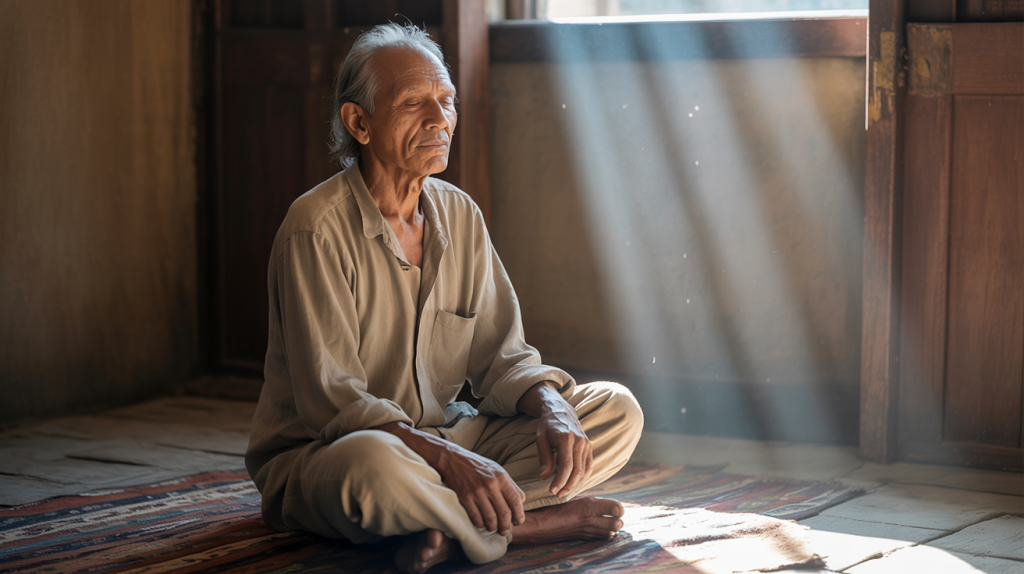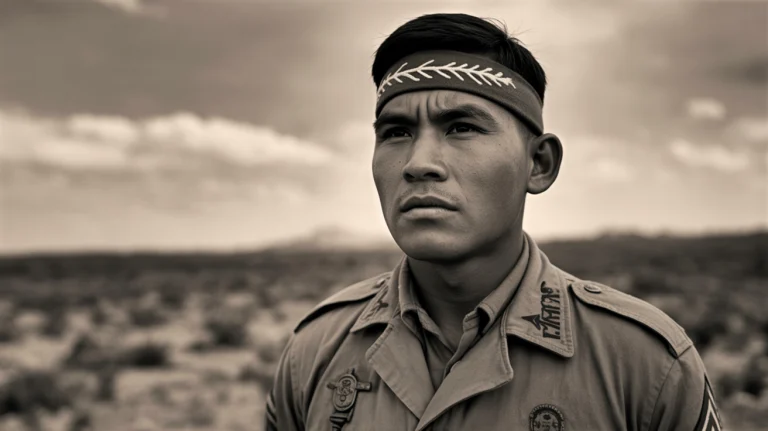In our fast-paced modern world, millions of people turn to meditation as a refuge from stress and a pathway to inner peace.
While various meditation techniques and soundscapes exist, few possess the profound spiritual depth and healing power of Native American music for meditation.
These ancient musical traditions, rooted in thousands of years of indigenous wisdom, offer a unique gateway to mindfulness, emotional healing, and spiritual connection.
Native American meditation music encompasses far more than beautiful melodies—it represents a living tradition that has helped countless generations find balance, healing, and connection to the natural world.
From the hauntingly beautiful tones of the Native American flute to the rhythmic heartbeat of traditional drums, these musical practices offer modern practitioners powerful tools for achieving deep meditative states and lasting inner transformation.
Whether you’re a seasoned meditation practitioner seeking new dimensions of practice or someone just beginning their mindfulness journey, understanding and respectfully incorporating Native American healing music can enrich your spiritual path in profound ways.
This comprehensive guide will explore the rich tradition of Native American spiritual music, explain why these sounds are so effective for meditation, and provide practical guidance for incorporating these sacred traditions into your daily practice.
Throughout this exploration, we’ll emphasize the importance of approaching these traditions with respect and cultural sensitivity, ensuring that our appreciation supports rather than appropriates indigenous cultural heritage. Let’s begin this journey into the transformative world of Native American meditation music.
The Sacred Tradition of Native American Meditation Music

Historical Roots in Spirituality and Healing
The tradition of using music for healing, meditation, and spiritual connection runs deep in Native American cultures, stretching back thousands of years across hundreds of distinct tribal nations.
Unlike Western concepts of meditation that often focus on silence, many indigenous traditions recognize sound as a powerful vehicle for achieving altered states of consciousness and connecting with the spiritual realm.
Native American spiritual music served multiple purposes within traditional societies: facilitating communication with ancestors and spirit guides, supporting healing ceremonies, marking seasonal transitions, and providing a pathway for personal transformation.
These weren’t casual performances but sacred practices that required extensive training, cultural knowledge, and spiritual preparation.
Archaeological evidence suggests that flutes, drums, and other musical instruments played central roles in Native American spiritual practices for millennia.
Cave paintings and artifacts found throughout North America depict musical ceremonies and instruments, indicating the deep historical significance of sound in indigenous spiritual traditions.
Traditional Instruments for Sacred Sound
The most recognizable instrument in Native American flute meditation practices is the wooden flute, traditionally crafted from cedar, walnut, or other sacred woods.
These instruments, often called “love flutes” or “courting flutes,” produced haunting, breathy tones that naturally induced meditative states.
The five or six-hole design created pentatonic scales that sound harmonious regardless of the note combinations played.
Native American drumming meditation traditions center around frame drums, water drums, and hand drums that create rhythmic patterns believed to mirror the human heartbeat and the pulse of Mother Earth.
These steady, repetitive beats help practitioners enter trance-like states conducive to healing and spiritual insight.
Rattles, made from gourds, turtle shells, or other natural materials, add textural elements to ceremonial music.
The gentle shaking creates white noise-like sounds that help quiet mental chatter and support deep relaxation.
Many practitioners find that rattle sounds naturally synchronize with breathing patterns, enhancing mindfulness practices.
Vocal traditions, including chanting and the use of “vocables” (syllables that carry spiritual meaning beyond literal translation), form another crucial component of Native American meditation music.
These vocal practices often incorporate call-and-response patterns that create community connection while facilitating individual spiritual experiences.
Song Structure and Spiritual Significance
Traditional Native American meditation songs follow specific structural patterns that enhance their meditative qualities.
Repetition plays a central role, with phrases, rhythms, and melodies cycling in ways that help practitioners release analytical thinking and enter deeper states of consciousness.
The pentatonic scales commonly used in Native American music create natural harmonic relationships that many listeners find deeply soothing.
These five-note scales avoid the tension points found in Western major and minor scales, producing sounds that feel both exotic and familiar to most listeners.
Many traditional songs incorporate natural sound elements—wind, water, bird calls, and other environmental sounds—that help practitioners feel connected to the natural world.
This integration reflects indigenous worldviews that see humans as part of a larger web of relationships with all living beings.
The use of vocables in Native American chanting meditation serves important functions beyond their literal meanings.
These syllables often represent emotional or spiritual states rather than specific words, allowing practitioners to connect with feelings and experiences that transcend ordinary language.
Why Native American Music is Profoundly Effective for Meditation

The Science Behind Sacred Sounds
Modern neuroscience research has begun to validate what indigenous peoples have known for millennia: specific types of music can dramatically affect brainwave patterns and states of consciousness.
Studies show that the rhythmic patterns common in Native American drumming meditation can induce theta brainwave states associated with deep meditation, creativity, and healing.
The repetitive nature of traditional Native American music helps quiet the default mode network in the brain—the neural circuits responsible for self-referential thinking and mental chatter.
When this network becomes less active, practitioners often report feelings of unity, peace, and expanded awareness characteristic of profound meditative states.
Research published in neuroscience journals demonstrates that drumming at specific frequencies can synchronize brainwaves, leading to enhanced focus, reduced anxiety, and improved emotional regulation.
The steady 4-7 beats per second commonly found in traditional drumming matches the theta brainwave frequency associated with deep meditation and healing.
Breathing and the Native American Flute
Native American flute music for meditation naturally supports mindful breathing practices. The breathy, flowing tones of traditional flutes encourage slow, deep breathing patterns that activate the parasympathetic nervous system and promote relaxation responses throughout the body.
Many practitioners find that listening to Native American flute music automatically slows their breathing rate and deepens their breath.
The sustained notes and gentle melodic phrases create natural breathing cues that help establish rhythmic, meditative breathing patterns without conscious effort.
The circular breathing techniques used by traditional flute players create continuous sound streams that seem to flow endlessly.
This unbroken sound quality helps practitioners maintain sustained attention and avoid the mental disruptions that can occur when music has abrupt starts and stops.
Emotional and Spiritual Healing
Practitioners and researchers consistently report profound emotional healing experiences when using Native American healing music in meditation practice.
The combination of rhythmic patterns, melodic structures, and cultural intentions embedded in these traditions creates powerful therapeutic experiences.
Many meditation teachers incorporate Native American music specifically for sessions focused on trauma healing, grief processing, and emotional release.
The gentle, non-threatening nature of flute music combined with the grounding effect of drumming provides a safe container for exploring difficult emotions.
The spiritual dimensions of Native American meditation music extend beyond relaxation to facilitate experiences of connection with nature, ancestors, and larger spiritual realities.
Many practitioners report feeling deeply connected to the earth and experiencing expanded awareness when meditating with these musical traditions.
Types of Native American Meditation Music for Different Practices

Flute-Based Meditation Experiences
Native American flute music meditation offers perhaps the most accessible entry point for newcomers to these traditions.
Solo flute pieces provide gentle, flowing soundscapes perfect for breath-focused meditation, body scanning, and general relaxation practices.
Many modern recordings combine traditional flute music with natural environmental sounds—flowing water, wind through trees, bird songs—creating immersive soundscapes that help practitioners feel connected to nature even in urban environments.
These nature-integrated recordings are particularly effective for outdoor meditation or when seeking to bring natural elements into indoor practice spaces.
Duet flute recordings, featuring two or more flutes playing complementary melodies, create rich harmonic textures that can deepen meditation experiences.
The interweaving melodies provide focal points for attention while maintaining the flowing, non-demanding quality that makes flute music so suitable for contemplative practices.
Contemporary artists have also created extended flute meditation pieces specifically designed for long-form meditation sessions.
These compositions may last 30-60 minutes or more, providing continuous sound support for extended practices without the disruption of track changes.
Drumming and Shamanic Journey Music
Native American drum meditation serves different purposes than flute music, offering more structured rhythmic patterns that can facilitate specific types of meditative experiences.
Shamanic journeying—a traditional practice involving rhythmic drumming to induce altered states of consciousness—has gained popularity among contemporary meditation practitioners.
Traditional drumming patterns for meditation typically maintain steady beats around 200-220 beats per minute, a frequency that research suggests can induce theta brainwave states associated with deep meditation and heightened creativity.
These patterns help practitioners move beyond ordinary consciousness into expanded awareness states.
Group drumming experiences, whether live or recorded, create powerful collective meditation opportunities.
The layered rhythms of multiple drums playing together can induce profound states of unity and shared consciousness among participants.
Water drum recordings offer unique sonic qualities, with the water inside the drum creating distinctive tonal variations that many practitioners find especially conducive to deep meditative states.
The subtle pitch variations and resonant qualities of water drums provide rich sonic environments for contemplative practice.
Chanting and Vocal Meditation
Native American chanting meditation incorporates vocal traditions that use both meaningful words and abstract vocables to create meditative states. These practices often involve repetitive phrases that help quiet mental chatter while providing focus points for sustained attention.
Traditional songs often include call-and-response patterns that were historically used in group ceremonies.
Modern practitioners can engage with these patterns by listening and mentally participating in the responses, creating interactive meditation experiences that build community connection even in solo practice.
Throat singing and overtone chanting techniques found in some Native American traditions create complex harmonic structures that can induce profound altered states.
These practices require training to perform but offer rich listening experiences that naturally draw attention inward.
Contemporary artists have created fusion recordings that blend traditional chanting with modern ambient and world music elements.
While purists may prefer traditional recordings, these fusion pieces can provide accessible entry points for practitioners new to Native American musical traditions.
Modern Fusion and Integration
Many contemporary meditation music creators respectfully incorporate Native American musical elements into broader soundscapes designed for yoga, reiki, and general meditation practice.
These fusion approaches can make traditional sounds more accessible while maintaining respect for their cultural origins.
Native American music for yoga often combines flute and drum elements with modern instrumentation and production techniques.
These hybrid compositions support flowing movement practices while honoring traditional melodic and rhythmic patterns.
Reiki and energy healing practitioners frequently use Native American-inspired music for their sessions, finding that the gentle, flowing qualities of flute music and the grounding effects of drumming create ideal environments for healing work.
Some artists create guided meditation recordings that combine spoken instruction with traditional Native American musical elements.
These productions help newcomers understand how to work with the music while providing structured meditation experiences.
How to Integrate Native American Music into Your Meditation Practice

Creating Sacred Space with Sound
Establishing a dedicated meditation space enhanced by Native American music requires thoughtful consideration of both physical and energetic elements.
Begin by choosing a quiet location where you can listen without interruption, preferably somewhere you can maintain consistent practice.
Consider the acoustic qualities of your meditation space. Hard surfaces may create echoes that interfere with the subtle qualities of flute music, while overly soft furnishings might muffle the important rhythmic elements of drumming.
A balanced acoustic environment allows the full spectrum of traditional sounds to be heard clearly.
Many practitioners create small altars or sacred spaces that honor the cultural origins of the music they’re using.
This might include natural elements like stones, feathers, or plants, along with expressions of gratitude for the indigenous traditions that created these musical practices.
Lighting can significantly affect your meditation experience with Native American music. Soft, warm lighting or candlelight can enhance the contemplative atmosphere, while harsh artificial lighting might interfere with the peaceful states these musical traditions are designed to induce.
Guided Meditation with Traditional Music
Guided Native American meditation combines spoken instruction with traditional musical elements to provide structured experiences for practitioners at all levels.
These practices often begin with breathing exercises accompanied by gentle flute music, gradually deepening into more profound contemplative states.
A typical guided session might start with several minutes of breath awareness supported by Native American flute meditation music.
The flowing, unhurried quality of flute tones naturally encourages slow, deep breathing while providing a gentle focus point for wandering attention.
Body scanning meditation works particularly well with Native American healing music. The gentle, non-intrusive nature of traditional flute music allows practitioners to move awareness through their bodies without musical distractions, while the grounding qualities of subtle drumming help maintain embodied awareness.
Loving-kindness and compassion practices can be enhanced by Native American spiritual music that emphasizes connection and harmony.
The communal origins of many traditional songs support practices focused on extending care and goodwill to all beings.
Breathwork and Rhythm Synchronization
Native American flute mindfulness practices naturally support conscious breathing work due to the instruments’ breathy, flowing tonal qualities.
Many practitioners find that flute music automatically encourages deeper, slower breathing patterns that activate relaxation responses throughout the body.
Advanced practitioners may experiment with synchronizing their breathing to the natural phrases and pauses in traditional flute music.
This practice requires careful listening and can develop into a form of musical pranayama that deepens both breath awareness and musical appreciation.
Drumming meditation offers opportunities for different types of rhythm synchronization. Some practitioners align their breathing with drum beats, while others might synchronize heartbeat awareness or walking meditation steps with rhythmic patterns.
The polyrhythmic nature of some traditional Native American music—where multiple rhythm patterns occur simultaneously—can provide sophisticated training for divided attention and complex awareness practices.
Advanced practitioners might track multiple rhythmic elements while maintaining breath awareness and general mindfulness.
Technology and Authentic Listening
Modern technology offers numerous ways to access Native American meditation music, but the quality of your listening experience significantly affects the meditation benefits you receive.
High-quality headphones or speakers that accurately reproduce the full frequency range of traditional instruments enhance the meditative qualities of the music.
Streaming services like Spotify, YouTube, and specialized meditation apps provide extensive collections of Native American meditation music.
However, it’s important to research the authenticity and cultural appropriateness of recordings, seeking out music created by Native artists whenever possible.
Some practitioners prefer live music experiences when available. Attending powwows, cultural events, or concerts by Native American musicians can provide profound meditation experiences while supporting indigenous artists and cultural preservation efforts.
Creating personal playlists allows you to customize your meditation music selection for different types of practice.
Consider organizing music by intention (relaxation vs. energizing), length (short vs. extended sessions), or instrumental focus (flute vs. drumming vs. vocal).
Native American Meditation Music Online: Authentic Sources and Platforms

Streaming Platforms and Playlists
Native American meditation music Spotify offerings include both traditional recordings and contemporary interpretations, though quality and authenticity vary significantly.
Search for playlists curated by Native American artists or cultural organizations to ensure you’re accessing respectful, authentic content.
When exploring Native American music YouTube, look for channels run by Native musicians, cultural centers, or educational institutions.
These sources typically provide context about the music’s cultural significance while offering high-quality recordings suitable for meditation practice.
Insight Timer, a popular meditation app, features guided sessions and music tracks that incorporate Native American musical elements.
Many of these sessions include cultural context and guidance for respectful use of traditional sounds.
Pandora and other radio-style streaming services often have Native American or “world music” stations that can introduce you to various artists and styles.
However, these automated selections may mix traditional and contemporary music without providing cultural context.
Supporting Indigenous Artists and Creators
When choosing where to buy Native American flute music or other traditional recordings, prioritize platforms and distributors that compensate Native artists fairly.
Many Native musicians sell directly through their websites or at cultural events, ensuring that your purchases support the artists and their communities directly.
Organizations like the Smithsonian Folkways Recordings maintain extensive collections of authentic Native American music recorded with proper cultural protocols and artist compensation.
These institutional sources provide reliable access to traditional recordings while supporting cultural preservation efforts.
Some streaming platforms now offer features that highlight indigenous artists and provide cultural context for traditional music.
Seek out these curated collections when exploring Native American meditation music online to ensure you’re accessing authentic, respectfully presented content.
Consider supporting Native American cultural centers and museums that offer music collections as part of their educational missions.
These institutions often provide valuable context about the spiritual and cultural significance of traditional music while supporting broader indigenous cultural preservation efforts.
Building Authentic Collections
Authentic Native American meditation music collections should include works by recognized Native artists who understand and respect the cultural traditions they’re representing.
Research artists’ backgrounds and tribal affiliations when building your collection to ensure authenticity.
Traditional recordings often provide more authentic meditation experiences than heavily produced contemporary interpretations.
Look for recordings that capture the natural acoustic qualities of traditional instruments without excessive electronic processing or mixing with non-traditional elements.
Building relationships with Native American cultural organizations in your area can provide access to authentic music while supporting community efforts.
Many tribal cultural centers offer music collections, educational programs, and opportunities to experience traditional music in appropriate cultural contexts.
Consider the complete ceremonial context when collecting Native American meditation music. Understanding the original purposes and cultural protocols surrounding traditional songs enhances your appreciation while ensuring respectful use in your personal practice.
The Transformative Power of the Native Flute in Mindfulness Practice

Deep Listening and Sonic Meditation
Native American flute mindfulness practices often center around deep listening techniques that use the instrument’s unique tonal qualities as meditation objects.
Unlike many Western instruments, traditional Native flutes produce breathy, imperfect tones that include natural variations and subtle environmental sounds that can deepen meditative awareness.
The irregular breathing patterns audible in traditional flute playing can teach practitioners about accepting imperfection and finding beauty in natural variation.
This acceptance practice naturally extends beyond music into other areas of life, supporting the development of non-judgmental awareness.
Many meditation teachers use Native American flute music specifically for concentration training because the gentle, flowing melodies provide clear focal points without becoming overwhelming or demanding.
The music supports sustained attention while remaining soft enough to allow deeper states of consciousness to emerge.
Advanced practitioners may work with the spaces between notes—the silence that gives flute music much of its power.
These practices develop subtle awareness and appreciation for emptiness, important skills in many contemplative traditions.
Breathwork Integration and Rhythmic Awareness
The circular breathing techniques traditional flute players use create continuous sound streams that can serve as breathing guides for meditation practitioners.
Following these extended tones helps develop longer, more controlled breathing patterns that support deeper meditative states.
Some practitioners experiment with humming or toning along with Native American flute recordings, creating participatory meditation experiences that combine listening with vocal practice.
This active engagement can deepen the meditation experience while honoring the communal traditions from which this music emerges.
Breathwork with Native flute music often involves matching breath rhythm to the natural phrasing of traditional melodies.
This practice requires careful listening and can develop into sophisticated breath control techniques that enhance both meditation and general well-being.
The natural pauses and breathing spaces in traditional flute music provide excellent opportunities for practicing breath retention and awareness of the spaces between breaths. These subtle practices can significantly deepen meditation experiences over time.
Emotional Healing and Spiritual Connection
Many practitioners report profound emotional healing experiences when working with Native American flute meditation music.
The gentle, non-threatening quality of flute tones provides a safe container for exploring difficult emotions while the cultural intentions embedded in traditional music support healing and transformation.
Native flute healing stories from contemporary practitioners often describe experiences of grief release, trauma healing, and spiritual breakthrough facilitated by regular meditation with traditional music.
While individual experiences vary, the consistent reports of healing suggest that these musical traditions carry genuine therapeutic power.
The connection to nature embedded in traditional Native American music can facilitate profound spiritual experiences for practitioners seeking to reconnect with the natural world.
Many report feeling more grounded and environmentally connected after regular practice with these musical traditions.
Some practitioners develop ongoing relationships with specific flute recordings or artists, finding that repeated listening to the same pieces deepens their meditation experience over time.
This practice honors the traditional view of music as a living relationship rather than passive entertainment.
Cultural Sensitivity and Respectful Engagement
Understanding Appropriation vs. Appreciation
When incorporating Native American music into meditation practice, it’s crucial to understand the difference between cultural appreciation and appropriation.
Appreciation involves respectful engagement that honors the source culture and supports Native communities, while appropriation takes cultural elements without permission, context, or compensation.
Respectful use of Indigenous music respect practices includes learning about the cultural contexts from which the music emerges, supporting Native artists financially, and avoiding claims of personal ownership or expertise in traditions that aren’t part of your cultural heritage.
Many Native American communities welcome respectful interest in their musical traditions, especially when that interest translates into support for cultural preservation efforts and economic opportunities for Native artists.
Approach these traditions as a guest with genuine respect rather than as a consumer seeking exotic experiences.
Cultural appropriation Native American music often involves using traditional sounds or symbols without understanding their sacred significance or providing any benefit to the communities that created them.
Avoid this by researching the sources of your music and ensuring your practices honor rather than exploit indigenous traditions.
Supporting Native Communities and Artists
One of the most important ways to ensure your meditation practice supports rather than appropriates Native American traditions is to purchase music directly from Native artists or through organizations that fairly compensate indigenous creators.
Attending powwows, cultural festivals, and other Native American community events provides opportunities to experience traditional music in its proper cultural context while supporting community efforts.
These experiences often deepen understanding and appreciation of the spiritual dimensions of traditional music.
Many Native American cultural organizations offer educational programs that teach about traditional music in culturally appropriate ways.
Participating in these programs demonstrates respect for indigenous knowledge while supporting community-led cultural preservation efforts.
Consider making donations to Native American cultural preservation organizations, tribal colleges, or other institutions working to maintain traditional knowledge.
These contributions help ensure that future generations will have access to these powerful spiritual traditions.
Ethical Streaming and Purchasing Practices
When selecting streaming services or online music sources, research their policies regarding indigenous artists and cultural content.
Choose platforms that provide fair compensation to Native musicians and include cultural context for traditional recordings.
Read the descriptions and background information provided with Native American meditation music recordings to understand their cultural significance and proper use.
This information helps ensure respectful engagement while deepening your appreciation of the traditions.
Support Native artists when looking for authentic Native American meditation music by purchasing directly from their websites, at cultural events, or through distributors known to work fairly with indigenous musicians.
Consider the long-term impact of your music consumption choices on Native American communities.
Consistently choosing authentic, ethically sourced music helps sustain traditional artists and cultural preservation efforts.
Frequently Asked Questions About Native American Meditation Music
Is Native American Music Effective for Sleep and Relaxation?
Native American sleep music can be highly effective for promoting restful sleep due to its gentle, flowing qualities and connection to natural rhythms.
The non-demanding melodies and steady rhythmic patterns found in traditional flute and drum music naturally encourage relaxation and can help quiet mental chatter that interferes with sleep.
Many practitioners find that Native American flute music is particularly suitable for bedtime listening because it lacks the dramatic dynamic changes and complex arrangements that might cause alertness.
The breathy, organic tones of traditional flutes create soothing soundscapes that support natural sleep cycles.
However, it’s important to choose appropriate recordings for sleep use. Some traditional ceremonial music is intended to promote alertness and spiritual awakening rather than relaxation, so research the intended purposes of recordings before using them for sleep support.
The rhythmic patterns in some Native American drumming may be too stimulating for sleep use, though gentle, slow drumming can provide effective relaxation support.
Experiment with different types of traditional music to find what works best for your individual sleep needs.
What Makes Native Flute the Best Meditation Instrument?
The best Native music meditation instrument is often considered to be the traditional wooden flute due to its unique acoustic properties and spiritual significance.
Native American flutes produce breathy, imperfect tones that naturally encourage deep listening and present-moment awareness.
Unlike Western concert flutes, traditional Native flutes include natural variations, breath sounds, and subtle environmental elements that create rich sonic environments for meditation.
These “imperfections” teach practitioners to accept natural variation and find beauty in authentic expression.
The pentatonic scales common in Native American flute music avoid the tension points found in Western major and minor scales, creating harmonious sounds that many listeners find inherently peaceful and meditative.
The cultural and spiritual intentions embedded in traditional flute music add dimensions of meaning and connection that purely instrumental meditation music may lack.
Many practitioners report feeling connected to something larger than themselves when meditating with traditional Native American music.
Can Non-Native People Respectfully Use This Music for Meditation?
Non-Native listeners can absolutely use Native American music for mindfulness practice when approached with respect, cultural awareness, and appropriate support for indigenous communities.
Many Native American musicians and cultural leaders welcome respectful interest in their traditions.
The key is ensuring that your engagement supports rather than exploits Native communities. This means purchasing music from Native artists, learning about cultural contexts, and avoiding claims of expertise or ownership of traditions that aren’t part of your heritage.
Approach these musical traditions as a guest with genuine respect rather than as a consumer seeking exotic experiences.
Take time to learn about the cultures and communities that created the music you’re using in your practice.
Consider participating in cultural education programs, attending community events, or supporting Native American organizations as ways to deepen your understanding while giving back to the communities that have preserved these traditions.
Where to Find Free and Authentic Native American Music
Free Native American meditation music can be found through various legitimate sources, though it’s important to balance accessibility with fair compensation for Native artists.
Some cultural organizations and educational institutions provide free access to traditional recordings as part of their educational missions.
YouTube channels run by Native American cultural centers, museums, and educational institutions often provide free access to authentic traditional music with appropriate cultural context.
These sources typically respect copyright and cultural protocols while making music accessible for educational purposes.
Some Native American artists offer free samples or limited recordings through their websites as a way to introduce listeners to their work.
These offerings often include information about purchasing full albums or supporting the artists’ other projects.
Libraries, particularly those in areas with significant Native American populations, may have extensive collections of traditional music available for borrowing.
Many university libraries also provide access to ethnomusicological recordings that include Native American traditional music.
However, remember that free doesn’t necessarily mean without cost to someone. Consider supporting Native artists and cultural preservation efforts through donations, purchases, or participation in community events even when accessing free music.
In Closing: Embracing the Sacred Path of Sound
Native American music for meditation offers contemporary practitioners a profound pathway to healing, spiritual connection, and deep inner peace.
These ancient traditions, preserved and shared by indigenous communities across generations, provide more than beautiful sounds—they offer doorways to expanded consciousness and authentic spiritual experience.
Throughout this exploration, we’ve discovered how Native American meditation music works on multiple levels: physiologically through its effects on brainwaves and breathing patterns, emotionally through its gentle healing qualities, and spiritually through its connection to larger sacred traditions.
Whether through the flowing melodies of traditional flutes, the rhythmic heartbeat of ceremonial drums, or the community-building power of traditional chants, these musical practices offer unique benefits for modern meditation practitioners.
The key to meaningful engagement with these traditions lies in approaching them with respect, cultural awareness, and genuine appreciation for their sacred origins.
By supporting Native artists, learning about cultural contexts, and ensuring our practices honor rather than appropriate indigenous wisdom, we can participate in these traditions in ways that benefit both ourselves and the communities that have preserved them.
As you begin or deepen your practice with Native American healing music, remember that you’re engaging with living traditions that continue to evolve and adapt while maintaining their essential spiritual power.
The rhythmic heartbeat of traditional drums still calls communities together for healing and celebration.
The haunting melodies of wooden flutes still guide individuals toward inner peace and spiritual insight. The collective power of traditional chants still creates bonds of community and shared purpose.
For those inspired to explore this path further, start with respectful listening and gradual integration into your existing meditation practice.
Seek out authentic recordings by Native artists, learn about the cultural traditions that created them, and consider ways to support the ongoing vitality of these sacred practices.
The sacred sounds of Native American meditation music invite us into a deeper relationship with ourselves, our communities, and the natural world.
May your journey with these traditions bring healing, insight, and connection to the sacred dimensions of life that these beautiful musical practices have served for countless generations.
In embracing these traditions with respect and appreciation, we honor not only our own spiritual development but also the resilience and wisdom of the indigenous peoples who have kept these sacred sounds alive through centuries of challenge and change.
The heartbeat continues, the flute songs flow, and the healing power of Native American music remains available to all who approach with open hearts and genuine respect.
Source: Mindfulness Exercises – Native American Music for Healing
Related Post: Native American Music






